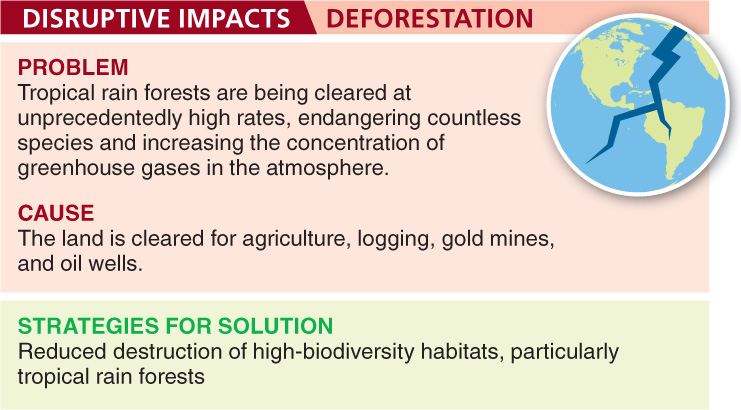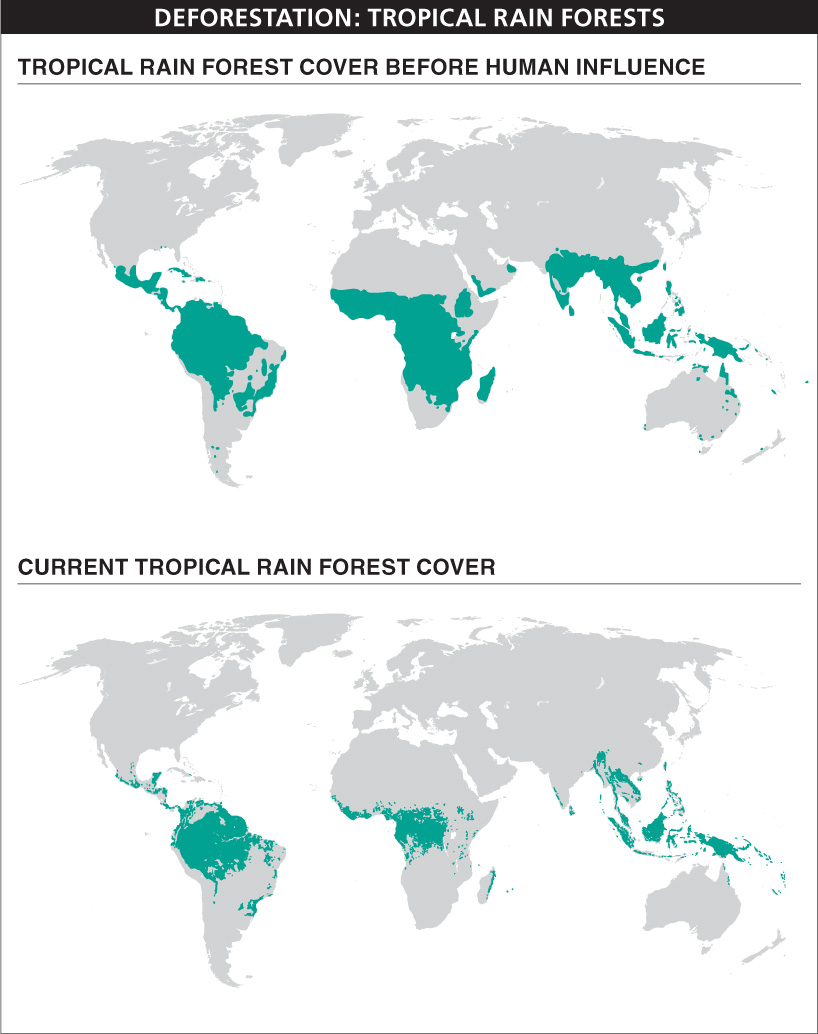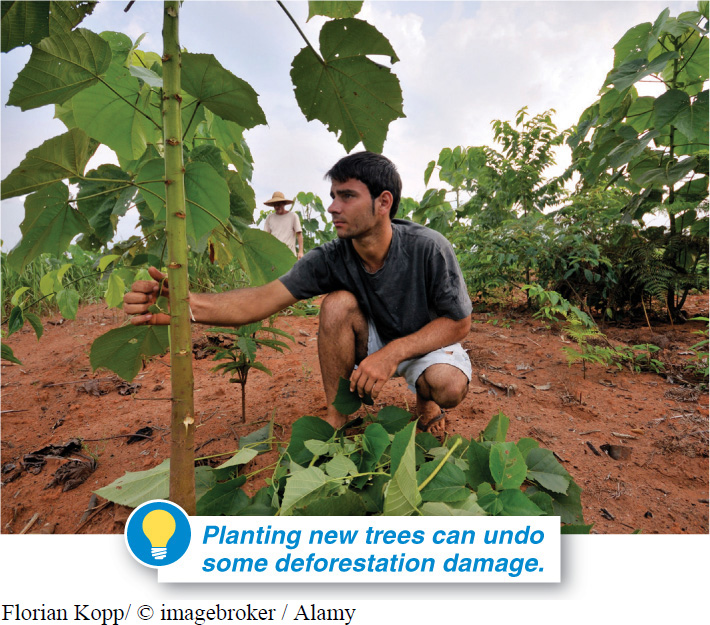Towering trees, colorful birds and butterflies, maybe a glimpse of Tarzan swinging past on a hanging vine—

Tropical rain forests grow in a region extending just a bit north and south of the equator, in South America, Africa, Asia, and Australia. As recently as a few centuries ago, that belt of rain forest covered about 6 million square miles (15.5 million square kilometers). More than half of that forest has already been destroyed, most of it in just the past 200 years (FIGURE 16-28).

The destruction of a tropical rain forest means an enormous loss of species, because these forests are the most diverse terrestrial habitats on earth. More than 170,000 species of plants grow in tropical rain forests—
672
Agriculture is responsible for the greatest loss of tropical forests, and it takes a variety of forms. Sometimes, a relatively small area is affected. In “slash-
Pollution from oil wells and mining in tropical rain forests has an impact that can extend far beyond the areas that are actually cleared. Leaking oil contaminates streams and groundwater, and acidic water drains from mines. Even worse, gold miners use mercury to extract gold, and some of the mercury enters streams, where it is converted to methyl mercury—
Agriculture and mining both require roads to bring equipment to the sites and take crops or minerals to market. Roads have an impact on forests that greatly exceeds the relatively small area they occupy, because they make access to the forest easy. Traveling through a virgin tropical rain forest is difficult—
Destruction of tropical rain forests has two serious environmental impacts: reducing the earth’s biodiversity and increasing the concentration of greenhouse gases in the atmosphere (which, in turn, affects global climate change).
1. Reducing biodiversity. Tropical rain forests of Africa, Asia, the Pacific region, and Central and South America, as we’ve seen, contain an unusually large number of species of plants and animals and probably other groups of organisms. Half of the world’s biodiversity hotspots are in tropical rain forests.
2. Increasing greenhouse gases. Photosynthesis in tropical rain forests removes an estimated 610 billion tons (550 trillion kg) of carbon dioxide from the atmosphere each year. As we learned earlier, accumulation of carbon dioxide in the atmosphere is the major cause of global warming. Thus, the continued photosynthetic activity of tropical rain forests is important in slowing the rate of warming. The huge quantity of carbon stored in rain forests can have a downside, however. When forests are cleared and burned, that carbon is released into the atmosphere. And tropical forests are being cleared at a frightening rate—
Because deforestation alters the characteristics of land cover, changing the proportion of solar radiation reflected and absorbed, destruction of the rain forests can have additional significant effects on climate—
673
The problem of tropical deforestation is one of the most difficult environmental problems to solve, and solving it will rely on international cooperation and involve multiple strategies: (1) identifying and protecting the most diverse areas; (2) addressing the poverty that drives the need to destroy rain forests for human activities; (3) developing alternative sources of food and income; (4) reducing population growth; and (5) making education about the value of biodiversity a central part of these solutions.
In spite of these varied and complex difficulties, numerous programs around the world are beginning to show some success (FIGURE 16-29). In the state of Pará, in the Brazilian Amazon, for example, encouraging progress has been made. As of 2012, this region, which is three times the size of California, has nearly eliminated illegal deforestation by adopting several new forest management practices.

- Accountability and protection: establishing a local system requiring landowners to register their holdings and an environmental police force to identify and punish illegal deforestation.
- Education: creating training programs for ranchers and farmers to help them make more efficient use of already-
deforested land. - Better forest management: developing environmentally sound infrastructure, such as reducing the building of new roads, long associated with increasing deforestation, in favor of improving existing roads and thus enhancing the ability to bring renewable forest products to market.
The initial transition is difficult, particularly because it can be accompanied by job losses. But efforts are under way to offset the loss of jobs associated with deforestation with increased economic development in non-
TAKE-HOME MESSAGE 16.11
Tropical rain forests are being destroyed at an alarming rate. This deforestation is devastating, for two main reasons. First, tropical rain forests contain more species of plants and animals than all other terrestrial habitats combined, and half of the earth’s biodiversity hotspots are in these forests. Second, tropical rain forests remove more carbon dioxide from the atmosphere than any other terrestrial habitat and, as a result, these forests are enormously important in limiting global warming. Deforestation further influences climate change by altering land cover characteristics. Programs addressing the complex difficulties of slowing tropical deforestation are beginning to see some encouraging results.
List some of the challenges that must be faced in addressing the problem of tropical deforestation.
(1) The most diverse areas must be identified and protected, (2) the poverty that necessitates the destruction of tropical forests must be dealt with, (3) alternative sources of food and income must be developed, (4) population growth must be reduced, and (5) education about the value of preserving biodiversity must be increased.
674